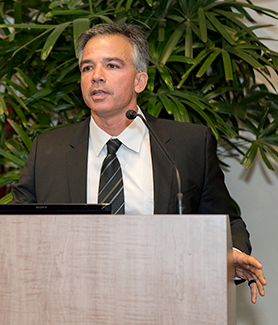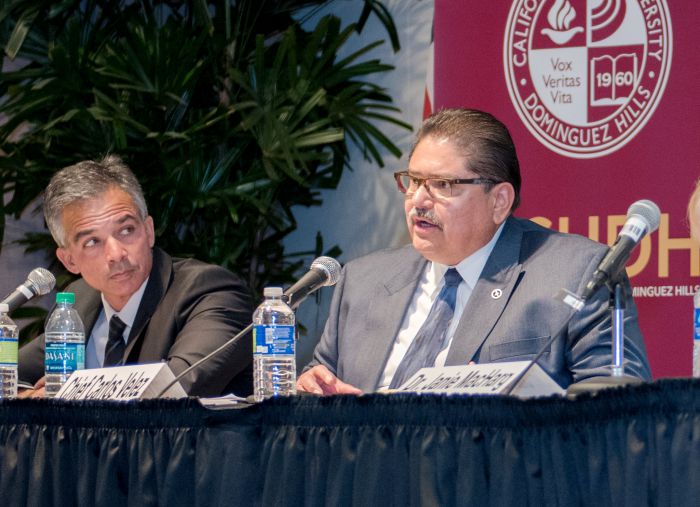
As the University Police Department carries out its more proactive and campus-inclusive approach to law enforcement, California State University, Dominguez Hills (CSUDH) is benefitting from its lowest crime rate in decades, but the campus community must still remain on guard in an era of increased campus violence.
To lend a hand to the department’s 20 sworn officers and 15 civilian employees, CSUDH encouraged a group of nearly 300 now well-informed observers during the “Understanding and Preventing Campus Violence” forum on March 2 to keep a look out for signs of suspicious behavior that could lead to violent acts.
Along with identifying individuals who may have a propensity toward violence–whether students, staff, faculty or outsiders–the audience also learned the steps to personally or indirectly addressing the issue.
Delivering the information during the forum was a panel of campus experts, campus police, and renowned forensic psychologist Kris Mohandie, who provided the keynote address.
“I often make the comment that school violence is the ‘we’ problem,” said Mohandie. “It is not the exclusive domain of law enforcement, or the exclusive domain of the campus administration. Everybody shares in the responsibility of being the eyes, ears and mouthpieces of potential risks.”
Mohandie has over 20 years of experience in the assessment and management of violent behavior. He is author of the book “School Violence Threat Management,” and has developed a popular school violence threat management program.
Click here to find the University Police Department webpage and learn more about crime prevention on campus.
In the past, a violent crime on a university campus in the U.S. would occur approximately once every 250 days. A recent study has shown that it has increased to nearly every 60 days, according to Mohandie.

“The first thing that you should take away from today is that there are myths about this problem, such as it won’t happen here. The reality is that these events can happen anywhere,” said Mohandle. “The second myth is that there is nothing that we can do about it, that there are no warning signs, and that these people just snap. There are warning signs and linkage that predates most of these events. And if it gets reported there is a considerable chance that we can actually interrupt the pathway to violence.”
Mohandie shared the “three key component” systems in any good campus violence program. They is a system to identify potential problems, to assess a person’s risk potential once identified, and a system for managing people who have been identified.
One of the best practices for a university campus is to build a multidisciplinary threat assessment team, which can consist of administrators, police representatives, mental health professionals, and a legal representative. The team should then develop and distribute to the appropriate members of the campus community tips for identifying individuals who may be a risk, as well as “windows of vulnerability” that enable action to help reduce the chance of them acting out.
“We are looking for somebody giving signals that they may be capable of hurting themselves or others, or have been seen in possession of something that can be used as a weapon,” said Mohandi. “Look for people who seem to be obsessed with violence. And once someone is identified, it is important to have a system for assessing it. First and foremost, identify it there’s an immediate need to respond.”
Following Mohandie’s address, Lt. David Hall shared with forum attendees information regarding the department’s more comprehensive approach to law enforcement and the success it has achieved since Chief Carlos Velez joined the department in 2011.
Officers each receive 100 hours of training every two years and train regularly with the Los Angeles County Sheriff’s Department. They can respond in “less than a minute” to a problem anywhere on campus 24/7, according to Hall.
“The good news is that here at Cal State Dominguez Hills we have had nothing short of a stunning crime reduction. Over the last five years, since the chief took over, we have reduced all crime–crime of violence and property crime–by 80 percent,” said Hall. “We refocused and restructured our entire department. We got some additional resources, and crime is now almost non-existent on campus.”

Hall was followed a panel of CSUDH leaders whose work relates to dealing with potentially violent threats in some way. They were Janie Macharg, director of Student Health and Psychological Services; David Braverman, interim associate vice president of Student Life and dean of students; Chief Velez, Associated Student, Inc. representative Stephanie Castellanos; and Mohandie. The panel fielded questions from the audience and its moderator, Gus Martin, professor of Criminal Justice Administration at CSUDH.
Velez was asked about the department’s measures that have resulted in the significantly lower crime rate on campus. Along with more strategic patrol, the department has launched several student and staff outreach programs on campus, and it has distributed “satisfaction surveys” to seek input from the campus community, he said.
“We’re conducting what’s known as preventative patrol, which includes the officers driving around the campus perimeter, and they get out of their cars to walk foot beats,” said Velez. “…The concept that we can do this together is an important one. We need to know ahead of time before something occurs on campus. We need all of your help.”